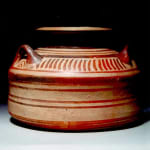Mycenaean Terracotta Pyxis, 14 Century BCE - 13th Century BCE
Terracotta
4
X.0087
The Mycenaean culture dominated Greece during the Bronze Age with its power, art, and wealth. According to legend, the city of Mycenae was founded by the hero Perseus on the...
The Mycenaean culture dominated Greece during the Bronze Age with its power, art, and wealth. According to legend, the city of Mycenae was founded by the hero Perseus on the shores of the Peloponniese. A land of valiant warriors, Mycenae is celebrated by Homer as the home of Agamemnon, the heroic king who led the Greeks to victory against Troy. Furthermore, recent archaeological excavations of Mycenaean palaces attest to their wealth, described by Homer as “:Mycenae, rich in gold.” Culturally, the Mycenaeans were heavily indebted to the Minoan civilization of Crete. Noted for their utilitarian pottery, Mycenaean vessels have been excavated throughout the Mediterranean, attesting wide range of their influence on the art and commerce of the ancient world. The script of Linear B was employed by Mycenaean scribes to record their early Greek language. Linear B would replace Linear A, the script of the Minoans, on Crete, revealing that the Mycenaeans would grow to dominate the civilization they grew out of. Although the Mycenaean civilization began to mysteriously decline after the 13th Century B.C., ruins of their constructions, described as Cyclopean because early historians thought only the Cyclops was capable of building with such large boulders, survive today, testifying to the greatness of this ancient culture.
This terracotta pyxis has a circular body articulated with decorative bands painted in an orange/brown hue. Three hands are attached to the shoulders that gradually taper inwards towards the short neck. The wide mouth and flaring rim would have provided easy access to the contents once stored inside, likely perfumes or fragrant unguents. The vessel is adorned with concentric bands of orange/brown paint, from the flat bottom to the flaring rim. This ancient vessel bears a heavy debt to Minoan pottery and is a type of ware that would have been exported throughout the Mediterranean world. Sweet smelling perfumes would have once flowed out from within the hollow confines of this vessel, be it in Greece, Egypt, or the Levant.
This terracotta pyxis has a circular body articulated with decorative bands painted in an orange/brown hue. Three hands are attached to the shoulders that gradually taper inwards towards the short neck. The wide mouth and flaring rim would have provided easy access to the contents once stored inside, likely perfumes or fragrant unguents. The vessel is adorned with concentric bands of orange/brown paint, from the flat bottom to the flaring rim. This ancient vessel bears a heavy debt to Minoan pottery and is a type of ware that would have been exported throughout the Mediterranean world. Sweet smelling perfumes would have once flowed out from within the hollow confines of this vessel, be it in Greece, Egypt, or the Levant.



